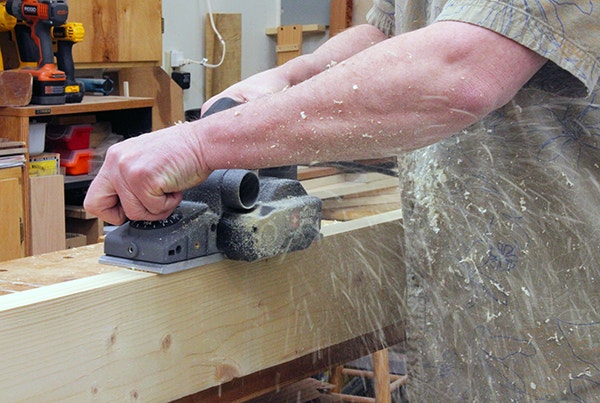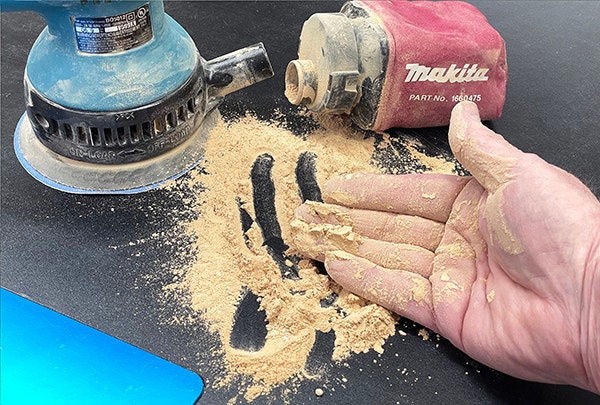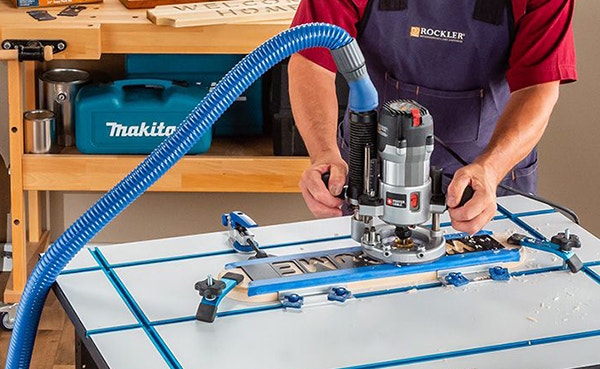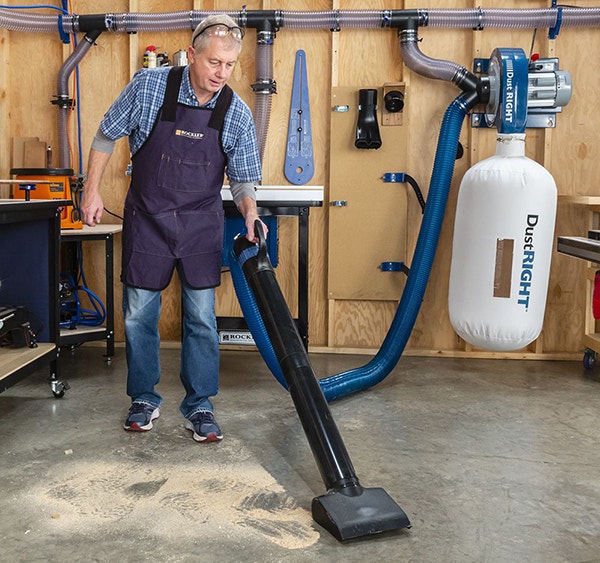Setting Up the Best Woodworking Dust Collection System
Setting up an efficient and easy-to-use dust collection system is important in every woodworking shop. A workshop with excessive piles of wood chips and surfaces coated in sawdust can affect how well you work and how much you enjoy being in your shop. More importantly, wood dust can directly impact your personal health and safety.
The best woodworking dust collection systems contain and collect dust at the source, minimize any mess that is left after your project is complete, make it easy to clean up the mess that is left behind, and makes your shop a healthier place to work. In this article you'll learn how to select and set up the best dust collector and dust collection accessories for your shop.
This article will answer the following questions related to Dust Collection.
- Is Wood Dangerous?
- What Air Flow CFM Rating Should My Dust Collector Produce?
- How Much Air Flow CFM Does Each Tool Need?
- What's the Difference Between Shop Vacuums and Dust Extractors?
- What's the Difference Between a Single-Stage and Two-Stage Dust Collector?
- What Fittings do I Need to Connect my Dust Collector to the Hoses and Tools?
- Dust Collection Tips for Challenging Tools
Why Do I Need a Woodshop Dust Collection System?
Woodworking projects tend to have three parts: Plan it. Build it. Clean up after it.
It’s that third part - clean up - that can take the joy out of a favorite activity. Every method of working wood – sawing, routing, planing, jointing, drilling, sanding, even whittling – creates waste in the form of dust of some consistency. Heavier chips and saw swarf pile up or go flying, while extremely fine dust becomes airborne and travels wherever the air currents take it.
And no matter how well you clean up your workspace afterward, wood dust – especially very fine dust – can go everywhere. If your shop is anywhere in your house, even separated in a basement or garage, fine dust can still find a way to travel to all parts of it. Even a freestanding workshop or garage can quickly turn into an uncomfortable dust-coated environment.
Is Wood Dust Dangerous?
The short answer: Absolutely. The nature of that danger depends on the type of dust being produced.
Physical Danger
At first glance, you’d consider that planers, jointers and routers create chips, not dust, and you’d be partially correct. These tools use a knife edge to scrape shavings or chips off wood. This heavier wood waste can fly a few feet or more, but quickly succumbs to gravity.
Without a means of collection in place, expect woodworking dust and chips to go everywhere. A vacuum hose or even a simple collection bag would easily contain this mess.
No problem, right? That’s why they invented brooms. But until you start sweeping, those chips and dust are everywhere you’re moving, creating a walking hazard. If your shop floor is extremely smooth, those chips can be slippery.
You also have to consider that flying chips don’t always fly where you want them to. At best, those chips will only go down your shirt, but can also fly right into your face and eyes. Even with eye protection, flying chips in your face are a dangerous distraction.
Saws create finer waste – the literal “sawdust” we talk so much about. Although it’s more on the granular side than chips or flakes, it can still fly, can still get into your face and eyes, and can still create a walking hazard.
Health Danger
Both of the above types of woodworking also create fine dust. You see the chips or sawdust, but there’s also a fine dust so light it’s difficult to see. Plus, it almost immediately becomes suspended in shop air.
It’s hard to even use the word “dust” to describe what sanders put out. It’s more an extremely fine powder than anything else, and possibly the most dangerous woodshop dust.
Then there’s even finer dust, the type generated by sanders that’s more powder than dust. This stuff is the most dangerous. Suspended in the air, you take in whole lungfuls every time you breathe. Short, minimal exposure is a respirational irritant. Longer exposure can worsen existing conditions like asthma or impaired breathing. In a worst case scenario, continued long-term exposure to extremely fine dust can lead to serious conditions such as pneumonitis, chronic bronchitis, emphysema and even various cancers.
Aside from respiratory issues, airborne fine dust is a constant irritant to skin and eyes. And if you have an allergy to any wood species – cocobolo, some cedars and many nut-based woods are commonly cited – your susceptibility is increased when the air is filled with fine dust.
Fire Danger
Your woodshop is an environment already filled with flammable material: wood. But properly stored, it’s not a particular danger in itself. But converting it to wood dust that goes everywhere can create fire hazards, a danger that only increases with the amount of dust produced.Sure, you can vacuum up most of this fine dust off the floor and other surfaces, but it can also collect on top of hot light fixtures, inside machinery housings, atop (and under) water heaters and furnaces, etc. The more that accumulates, the greater the risk.
Even if wood dust doesn’t spontaneously combust or cause an actual fire, should a fire start from other causes the dust can act as an accelerant or even, in extreme cases, an explosive fuel.
Annoyance
Aside from outright danger, dust is also a general annoyance that can impact how – and how well – you work.Larger chips and sawdust can build up in critical areas that prevent components from being worked accurately. Chip buildup might slightly tilt a workpiece against the face of a miter gauge, for example, or prevent a component from accurately resting against a stop. Chips underneath workpieces tend to lift the wood off a table even if only slightly, resulting in an inaccurate measurement or cut.
Fine airborne dust will absolutely settle on any freshly applied finish. Dust can also play havoc once it gets into the innards of machinery. Gears and belts, already attractive to dust because of lubricants, can quickly be caked with accumulated oily dust.
Any electronics in your shop? Fine dust will seep into laptops or other computer equipment, radios and other entertainment devices, even cell phones, causing excess heat and performance issues. In the case of any video screen – TV, laptop, phone, even small LCD screens on machinery – dust can creep in and coat the underside of the clear screen where it can’t be removed, affecting appearance and visibility.

This computer screen shows how fine dust has actually crept inside the left edge of the monitor.
There is no practical way to get this dust out.
As noted before, this fine dust will travel anywhere in your house that air moves, so expect furnace filters to clog more quickly, leading to a fine film of dust on every surface or your home.
Methods of Dust Collection
There are numerous ways to manage woodshop dust collection, and figuring out what is best for you depends on factors like the way you work, your particular workspace, and how much time and money you want to invest. Let’s take a look at the different ways to grab and contain dust.
On-Board Dust Collection
While it wasn’t always true, most of today’s hand-operated tools come with some means of collecting dust, typically a tool-mounted canister or bag. Although their effectiveness varies, you should always use these when possible.
Among the most basic means of controlling dust, a properly attached canister, such as this FlexiPort Dust Canister (left), or tool specific dust bag (right), will grab some of the dust produced by handheld power tools.
Virtually all miter saws and circular saws these days include a dust port and bag. These typically accomplish sawdust collection by means of centrifugal force – the spinning blade shoots the lion’s share of sawdust directly out the port and into the bag. Of course, that blade goes through a full 360-degree rotation, part of it on the other side of the workpiece, so a lot of sawdust gets flung elsewhere.
Handheld planers and biscuit joiners also use ports and bags, but are somewhat more efficient since the cut is “closed,” that is, the blades don’t penetrate the other side of the wood, so chips have only one direction to go – toward the bag. But you’re still relying on centrifugal force, so not everything is captured.
Sanders have seen the greatest improvement in dust collection, with bags and canisters that excel at grabbing fine dust. An impeller arrangement inside the sander actually creates a suction that, combined with perforations in sanding discs, draws dust through the tool and into the bag or canister. Again, though, some dust escapes. (Especially if you don’t empty the bag frequently.)
Some larger tools, like thickness planers , also use impellers that forcefully eject chips and shavings to a dust port and collection bag.
Hose-Assisted Dust Collection
Replacing canisters or bags with a hose connected to any vacuum source greatly increases the efficiency of these tools’ dust handling capabilities. Further, other tools that don’t typically come with collection receptacles, such as routers and drills, can be outfitted with dust shrouds that also connect to a hose.

Router dust collection can be difficult, but many newer machines incorporate a dust shroud into the tool base. Connected to a shop vacuum or dust collection system helps maintain a clean shop.
These methods work by combining the tools’ innate means of dust handling (centrifugal force or internal impeller) to guide dust away from the tool, and then using a vacuum source to forcefully draw it out of the tool and to a collection point. The means of providing a vacuum source – and attaching it – can vary.
What Size Vacuum or Dust Collector is Right for my Shop?
For single small tools – typically anything that uses a canister or small collection bag – a standard shop vacuum or dust extractor outfitted with a hose adapter like the Dust Right FlexiPort Connectors will do the trick in most cases. Ditto for many small benchtop tools. Of course, that takes into consideration that the vacuum will be rolled to where you’re working, and that it’ll be handling only the small volumes of dust those tools create.
For larger tools, stationary equipment, multiple connections, or collection running through a system of longer ducts, you’ll do better to consider collectors with more power.
I’m using “power” here as a catch-all phrase. Dust collector “power” is really a combination of a few factors: the horsepower of the collector system, air velocity (expressed in linear feet-per-minute or FPM), static pressure and, most importantly, the volume of air being moved (expressed in cubic-feet-per minute, or CFM). These figures intertwine and the topic can get technical fast, so the main rating you want to consider is when shopping for a dust collector is CFM. Learn more about how dust collection systems work and CFM demands for each tool.
What CFM Rating Does My Dust Collector Need?
Standard shop vacuums typically pull 100-200 CFM. Dust collectors generally start in the 450-650 CFM range, and go up from there depending on motor size.
Clearly, then, a shop vacuum is the most basic collection you can use, and although it isn’t the best it is far better than none at all. Plus, for tools that have internal impellers, combined with the centrifugal force of a spinning blade directing dust to the dust port they can be more efficient than simple CFM ratings would indicate.
Most small-shop stationary machinery, meanwhile, requires 300-600 CFM. Larger machines, of course, have higher CFM requirements. For stationary machines, then, a regular dust collector is the better choice.
VIDEO: Understanding CFM and How a Dust Collector Works
CFM Requirements for Each Tool
The chart below lists general CFM requirements for popular shop machinery.| Machine | CFM Requirements |
| Table Saw - 10" | 350 - 450 |
| Band Saw - 14" | 350 - 400 |
| Jointer - up to 8" wide | 350 - 450 |
| Planer - 12" | 500 |
| Planer -15" and larger | 600 - 900 |
| Disc Sander - 12" | 300 - 350 |
| Horizontal Belt Edge Sander | 550 - 600 |
| Vertical Belt Sander - up to 6" wide | 400 - 450 |
| Drum Thicknessing Sander - up to 12" drum | 400 |
| Drum Thicknessing Sander - 12" - 24" drum | 550 |
| Drill Press | 300 |
| Scroll Saw | 300 - 350 |
Types of Dust Collection Machines
Shop Vacuums and Dust Extractors

The easiest, least expensive and most readily available means is any standard shop vacuum. Hooked up to a tool, shop vacuums provide plenty of suction for handheld tool use, and even for some larger tools. Plus, shop vacuums easily roll to wherever you’re working. Their main downside is excessive noise and lack of power to handle the amounts of dust and large chips produced by larger stationary tools, but for smaller tools shop vacuums provide an excellent way to begin wrangling dust.
Shop vacuums are the workshop general-purpose means of dust collection, and as such are designed as all-round suck-’em-up machines. Sawdust, dirt, spilled pet food, even water can be picked up and sent to the shop vac’s tank. With few exceptions, they don’t discriminate – everything that comes through the hose ends up at the same place. That’s because most shop vacuums are single-stage machines that do not separate what they pick up, and generally incorporate only one type of filter medium.
Shop vacuum filters are usually pretty basic, and allow a lot of small particles – the kind that go airborne – to pass right through. Higher-end units offer better filtration, but they remain compromised by the lack of dust/debris separation and can clog quickly.
Still, shop vacuums come in a variety of sizes (including handheld models), are generally inexpensive, have high velocity that’s great for cleaning out small cracks and crevices, and they’ve rightly earned their spot in modern workshops.

A dust extractor is a step up from a shop vacuum. Generally larger and heavier than simple vacuums, extractors are designed specifically for handling dust. Nearly all extractors are two-stage machines that separate larger woodworking debris from fine dust, collecting each in separate areas of the machine. Their filters excel at grabbing extremely fine dust.
Whereas shop vacuums are low-volume/high-velocity machines, extractors are just the opposite and move a larger volume of air a bit more slowly. This increases efficiency for handling fine dust, much in the way larger standalone dust collectors do. Lower air velocity (along with better insulation and tighter seals) also makes them quieter machines than typical shop vacuums.

Dust extractors are more expensive than simple shop vacuums, but their higher efficiency and considerably better dust handling – especially for extremely fine dust – makes them an attractive option.
Best Upgrades for Your Shop Vacuum or Dust Extractor

The benefits of a two-stage collector can also be applied to shop vacuums. If you regularly use a shop vacuum in your shop, you can add two-stage functionality by attaching it to a Dust Right Dust Separator. When used with most power tools and shop vacuums, the Dust Right® Separator captures sawdust, wood chips, and other debris before it enters your vacuum, preventing the loss of suction power caused by a clogged vacuum filter.
Dust Collectors
The next step up from a shop vacuum is a true dust collector. More powerful and able to move a higher volume of air (measured in CFM or Cubic Feet Per Minute), dust collectors extend dust handling to even the largest – and sometimes multiple – stationary tools.

The Dust Right 750 CFM Mobile Dust Collector uses gravity to collect heavier dust and chips in the lower bag, while a top-mounted canister wrangles the fine dust.
Among dust collectors, there are two types. A single-stage collector sucks up dust, chips and shavings and then blows everything through the machine and into a collection bag. A two-stage collector adds a conical section before the bag that spins the dust as it enters, causing heavier chips to fall through to the bag, while lighter dust continues on to a filter.
Single-Stage Dust Collectors

Single stage dust collectors, like this Dust Right 1250CFM Dust Collector draw filthy air through the machine, and collect everything – fine and coarse – in a filter bag.
Two-Stage Dust Collectors

Two-stage collectors like this JET 1-1/2HP Cyclone Dust Collector include a cone-shaped section that separates heavy chips and dust to a lower collection can, then send finer particles to filter and separate bag.
LEARN MORE: Rockler Award Winning Dust Collectors
What is the Best Woodworking Dust Collection Hose Size?
As noted above, air-volume CFM ratings are important. However, a lot can affect that rating. Most dust collector specs given by the manufacturer are typically measured using a 4" duct or hose. Decrease that diameter and CFM drops; increase it and the CFM goes up. Think of drinking a thick milkshake – you don’t get much with a thin straw, but you get more with a fat one.
The two most common sizes of dust-collection hose or ducting used in small shops are typically 4" and 2-1/2". Use a 4" hose/duct, and you’ll get the rated CFM, but a 2-1/2" hose/duct cuts the CFM about in half. This doesn’t mean that 2-1/2" hoses aren’t any good – they are! They’re just less efficient. For that reason, use 4" hose/ducts whenever possible.

Rockler’s Dust Right Expandable 2-1/2"-dia. Hose retracts to allows the author’s planer to store out of the way against a wall when not in use. When needed, it stretches up to 12' to give plenty of working room.
Learn More: Choosing the Right 4"-dia. Dust Collection Hose
While 4" dust ports are common for most stationary woodshop machines, many, usually benchtop tools, use smaller 2-1/2" ports. For these, get your 4" hose or duct as close to the machine as possible and then use an adapter to connect the hose. This keeps most of the dust collection “run” at the wider diameter, delivering higher CFM from there to the collector.

This section of a dust collection system features a 4''-to-2-1/2'' Y-Connector between two 4" PVC pipes. Two Schedule 40 PVC to 4" Hose Adapters were used to splice in the Y-Fitting, The Y-Fitting diverts and reduces from a 4"-dia. to 2-1/2"-dia. hose that connects to one of the tools in the shop.
Hose/duct diameter aside, friction also affects CFM efficiency by increasing static pressure. Ribbed and flexible hoses create more friction than smooth hoses or tubes. Sharp turns in hoses and ducts are the biggest culprits, so try to keep duct/hose runs as straight as possible. For that matter, the length of the run also causes more friction, so shorter is always better. Mismatched connectors can create slowdowns, as can overuse of spiral hose.
Of course, all these things are often necessary components of connecting and running dust collection from the tool to the collector, so some decrease in efficiency is always to be expected. No system is perfect, but strive to keep things that affect CFM to a minimum.
What Fittings do I Need to Connect my Dust Collector to the Hoses and Tools?
Sometimes you’re lucky enough to be able to connect a tool directly to a collector, but when using a collector for multiple tools – especially in a duct-based system – you’ll quickly discover that one component of the system may not match or easily connect to another. For that, there’s a host of fittings available.

Today, some standardization is appearing, but there are also accessories geared specifically for dust collection that are readily available that make connections a lot easier. Rockler’s Dust Right FlexiPort connectors, utilize rubber fittings in different sizes that mold to fit tool dust outlets of almost any shape. The new Dust Right FlexiPort Click-Connect Upgrade Kit turns your FlexiPort hose kit into a quick connecting system.
VIDEO: NEW FlexiPort Click-Connect Upgrade Kit

A hose splice, like this Dust Right Ready-Mount 4” Hose Splice clamps in place to create hoses of any length.
Learn More: Choosing the Best Dust Hose Fittings
For certain applications you need a longer hose or to divert the line in different directions, especially when setting up a whole-shop system. The Dust RIght Ready-Mount Fittings include a variety of fittings that allow you to smoothly change directions, split into multiple lines or transition between two different size hoses. The key when changing hose diameters is to keep smaller connectors and hoses closer to the tool, and enlarge as the line returns to the dust collector. This will help maintain higher CFM for most of the length of the hose/duct.

PVC sewer and drain piping is a favorite for setting up ducts for a whole-shop dust collection system, but they don’t directly connect to most dust fittings. Rockler’s 4" fitting for PVC pipe easily makes the connection.

Dust RIght Ready-Mount Fittings, such as this Y-fitting create branches for dust collection hoses and ducts to connect two or more machines to the same system. .
In any system connected to multiple tools, you’ll want the airflow to go from only tool at a time to maintain peak CFM. Blast gates installed inline to each tool can open or close suction as needed.

Blast gates cut off the suction to tools that are not in use, focusing the dust collection suction on the tool that is being used.

Direct suction to only the machine you’re using with Stable Gate Blast Gates.
Learn More: Where and Why to Install Blast Gates
What is the Best Dust Collection System for Each Tool?
A direct connection between a hose and the tool is always the best method to collect dust at the source, but that’s not always possible with some tools. As with all things woodworking, there are no real standards between tool manufacturers for fitting item “A” to item “B.”
The trick, of course, is matching those ports to your system. Fortunately, most stationary and benchtop tools feature 2-1/2"- and 4"-dia. ports that can easily be connector directly to 2-1/2" and 4" hoses. However, handheld and benchtop power tools often have much smaller ports – usually 1-1/4" and 1-1/2" – so connecting a larger hose requires an adapter that mates to larger hoses. Some tools, like sanders, have ports as small as 3/4", or even oddly shaped ports.
Rockler’s Dust Right FlexiPort connectors feature flexible mating sleeves to help match these.

Tool dust ports can come in weird shapes, but Rockler’s Dust Right FlexiPort connectors feature soft, rubbery connectors that shape themselves to match.
Learn More: Dust Right Ports and Fittings
Dust Collection Tips for Challenging Tools
Routers
Routers, by their nature, need the spinning bit to be exposed. And because they’re spinning a full 360 degrees it’s impossible to fully enclose them and catch all the dust they produce. Handheld router dust collection can be improved by attaching a dust shroud that encloses the base or a shroud that partially encircles the bit. Centrifugal force directs chips to the shroud, while vacuum suction pulls in as much as possible. Some chips will always escape, however.

When it comes to dust collection for handheld router edge routing, the Dust Right Edge-Routing Dust Port attaches to any router that accepts a standard 1-1/4'' diameter guide bushing, and partially surrounds the bit to capture dust when flush trimming or routing decorative edge profiles. .
When you need dust collection at a router table, the dust can be collected at two points. A fence-mounted port above the table grabs chips and dust as with handheld routers, but a shroud like housing underneath the table contains everything else. The dust collection hose is split between these two points – one to the tabletop, one to the under-table housing.

Router table dust collection works best when it grabs dust both above and below the table at the same time. The Dust Right Router Table Dust Bucket mounts below the table, but also allows a separate connection to a fence-mounted dust port.

The Rockler Fence Port Dust Brush does double-duty as both a cleanup brush and the hose to the dust port on your fence. Just pull it off the port to clean up stray dust and chips that collect on your router table or drill press.
Lathes
Lathes are more problematic, as chips and debris tend to fly everywhere. But a similar shroud enclosure can have a big impact on getting most of it. Lathe dust shrouds typically mount to the lathe bed or on a freestanding support, with the shroud adjusted as close as it can get behind and around the workpiece. You’ll still have chips that shoot to the side (and all over you), but a lathe shroud can make a huge difference.

Mounting a collection hood, such as this Dust-Right Lathe Dust Collection Hood behind the workpiece on a lathe helps tame the mess.
LEARN MORE: Setting Up a Lathe Dust Collection Hood
Lathe shrouds are more efficient when sanding on the lathe, one of the most intensive fine-dust producing activities you can do in the shop. Heavier chips aren’t shooting everywhere when sanding, nor do you need maneuvering room for using chisels. For sanding, shrouds can be adjusted closer to the spinning workpiece, creating a strong backdraft that pulls fine dust into the shroud and on to the dust collector.
Miter Saws
Miter saws are one of the most challenging tools in terms of dust collection. Most of the miter saw blade is exposed and chips fly back behind the tool. Some miter saws feature more effective dust shrouds behind the blade, but many saws do very little to contain the dust.

One option to help improve dust collection dust at your miter saw is to install a hood behind your miter saw.
Learn More: Easy Dust Collection Upgrades
Air Filtration Systems
We’ve talked entirely about collecting dust at the source, but no matter how efficient your dust collector system is, there will always be fine, powdery dust that escapes into the air. This will eventually settle, but until it does you’re breathing it and it’s spreading throughout your shop and home.Shop vacuums and dust collectors, no matter how powerful or efficient, aren’t designed to filter shop air. For that, consider an air filtration system, sometimes called an ambient air cleaner. These units are usually metal boxlike structures with an internal fan that draws shop air in and through a pair of filters. The first separates and catches heavier airborne dust, while a second extremely efficient filter grabs the tiniest particles.
Air filtration machines are often ceiling-hung, usually centrally in a shop, and constantly recirculate and filter shop and filter shop air. Typical units vary from 450-1200 CFM, but larger cleaners are available. Better models have multiple speed selections and a remote control.

No shop vacuum or dust collection system can pull powder-like dust out of the air, but that’s where air filtration units shine. This JET 1000CFM Air Filtration System constantly filters and recirculates shop air while you work.
Any Dust Collection is Better Than No Dust Collection.
Setting up an efficient and easy-to-use dust collection system is important in every woodworking shop.Not implementing a dust solution because your dream collection system is beyond your means is no solution at all. It’s perfectly fine to start small, and improve dust handling as you’re able. understand a fundamental truth: Any dust collection is better than no dust collection. The best woodworking dust collection systems contain the mess that is created by tools, make it easy to clean up any mess that is left behind, and makes your shop a healthier and better place to work.
Keep the inspiration coming!
Subscribe to our newsletter for more woodworking tips and tricks



